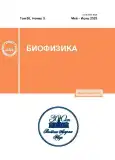Обработка нитроцеллюлозных мембран в тлеющем разряде повышает чувствительность иммуноанализа
- Авторы: Петрова П.А1, Замалутдинова С.В1, Внукова А.А1, Алексеева Д.А1, Багров Д.В1
-
Учреждения:
- Московский государственный университет имени М.В. Ломоносова
- Выпуск: Том 68, № 3 (2023)
- Страницы: 435-441
- Раздел: Статьи
- URL: https://journals.rcsi.science/0006-3029/article/view/144442
- DOI: https://doi.org/10.31857/S000630292303002X
- EDN: https://elibrary.ru/FPJRBX
- ID: 144442
Цитировать
Полный текст
Аннотация
Ключевые слова
Об авторах
П. А Петрова
Московский государственный университет имени М.В. ЛомоносоваМосква, Россия
С. В Замалутдинова
Московский государственный университет имени М.В. ЛомоносоваМосква, Россия
А. А Внукова
Московский государственный университет имени М.В. ЛомоносоваМосква, Россия
Д. А Алексеева
Московский государственный университет имени М.В. ЛомоносоваМосква, Россия
Д. В Багров
Московский государственный университет имени М.В. Ломоносова
Email: bagrov@mail.bio.msu.ru
Москва, Россия
Список литературы
- R. Hawkes, E. Niday, and J. Gordon, Anal. Biochem., 119 (1), 142 (1982).
- D. I. Stott, J. Immunoassay, 21 (2-3), 273 (2000).
- V. Faoro and G. Stanta, In Guidelines for Molecular Analysis in Archive Tissues, Ed. by G. Stanta (Springer, Berlin, Heidelberg, 2011), pp. 275-276.
- S. Zhang, et al., Analyst, 139 (2), 439 (2014).
- N. Tsurusawa, J. Chang, M. Namba, et al., J. Clin. Med., 10 (21), 5197 (2021).
- S. Watabe, H. Kodama, M. Kaneda, et al., Biophysics (Japan), 10, 49 (2014).
- J. Wang, et al., PLoS One, 8 (12). e82888 (2013).
- C. F. O. Hoy, et al., Sensing and Bio-Sensing Research, 26, 100304 (2019).
- N. Kaneko, et al., Inflamm. Regener., 39 (1). 12 (2019).
- C. A. Schneider, W. S. Rasband, and K. W. Eliceiri, Nat. Methods, 9 (7), 671 (2012).
- A. Li, et al., Cytotechnology, 65 (1), 71 (2013).
- T. H. Meltzer and M. Jornitz, Am. Pharmaceut. Rev., 6, 44 (2003).
- Z. Ashrafi, L. Lucia, and W. Krause, Soft Matter, 15 (45), 9359 (2019).
- I. Nikishin, et al., Micron, 145, 103044 (2021).
- D. V. Bagrov, et al. Microscopy Res. & Technique, 85 (2), 562 (2022).
- O. I. Volokh, et al., Front. Mol. Biosci., 9, 1048117 (2022).
- J. G. Dillard and I. M. Spinu, J. Adhesion, 31 (2-4), 137 (1990).
- P.-O. Bussiere, J.-L. Gardette, and S. Therias, Polymer Degradation and Stability, 107, 246 (2014).
- V. I. Kovalenko, et al., J. Struct. Chem., 34 (4), 540 (1994).
- А. М. Сенковенко и др., Биофизика, 67 (3), 555 (2022).
- О. Йосихито, Высокомолекуляр. соединения, 30 (9), 1815 (1988).
- T. Desmet, et al., Biomacromolecules, 10 (9), 2351 (2009).
Дополнительные файлы










